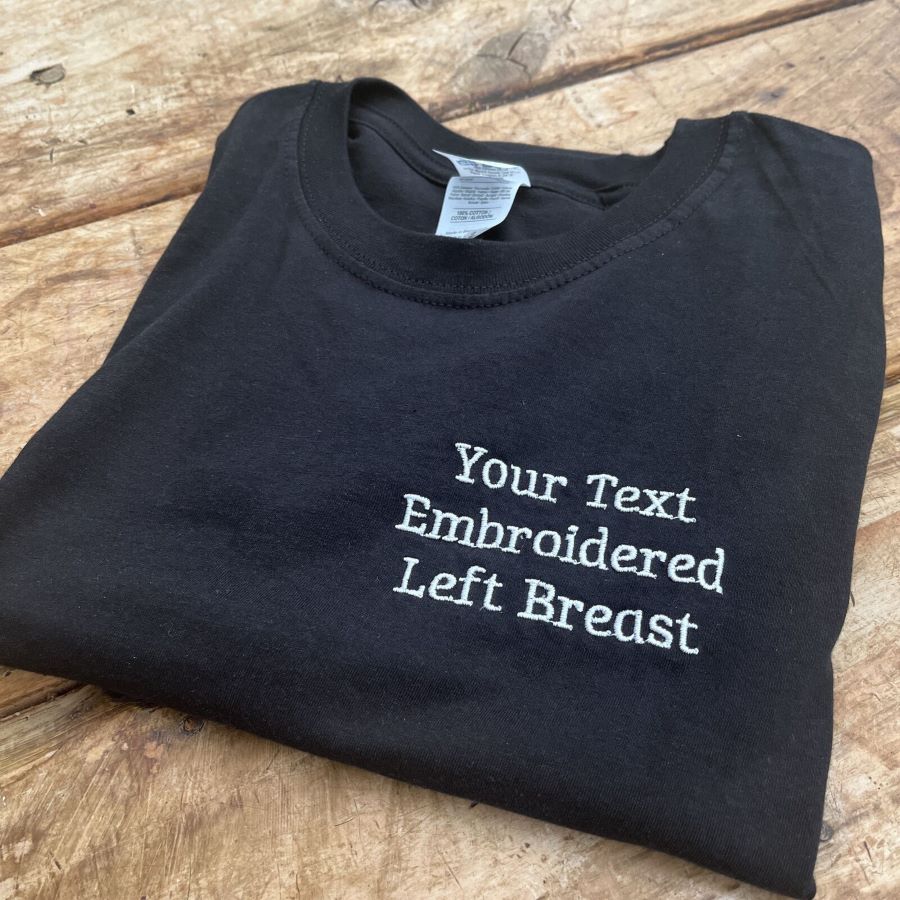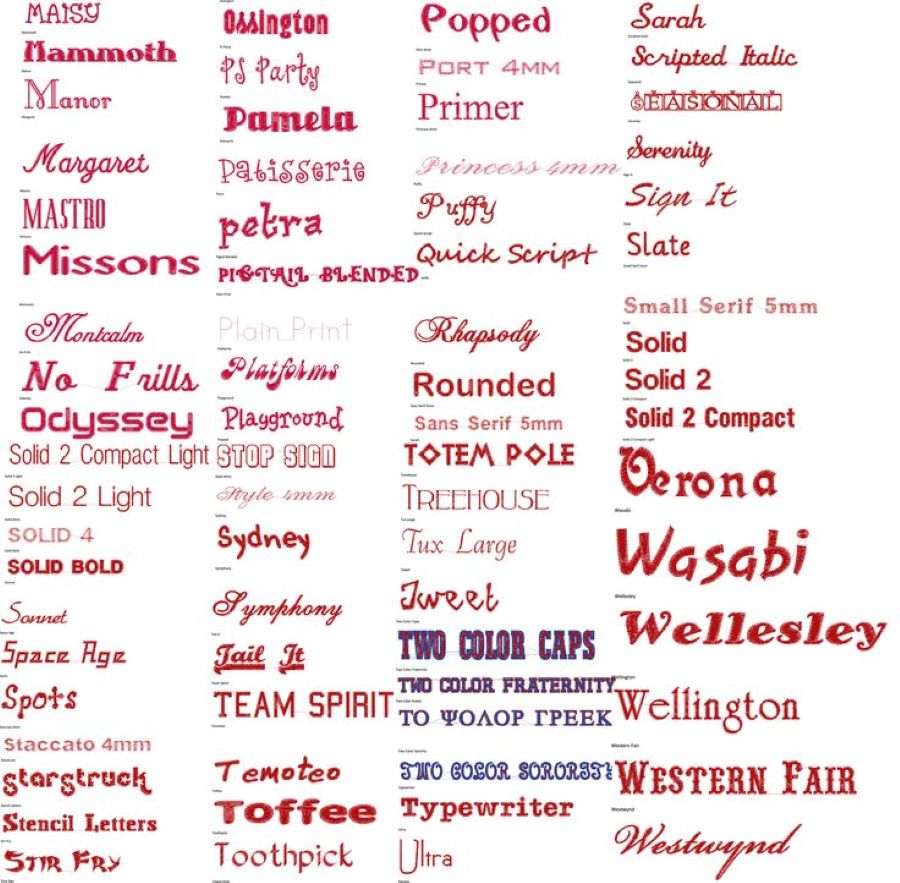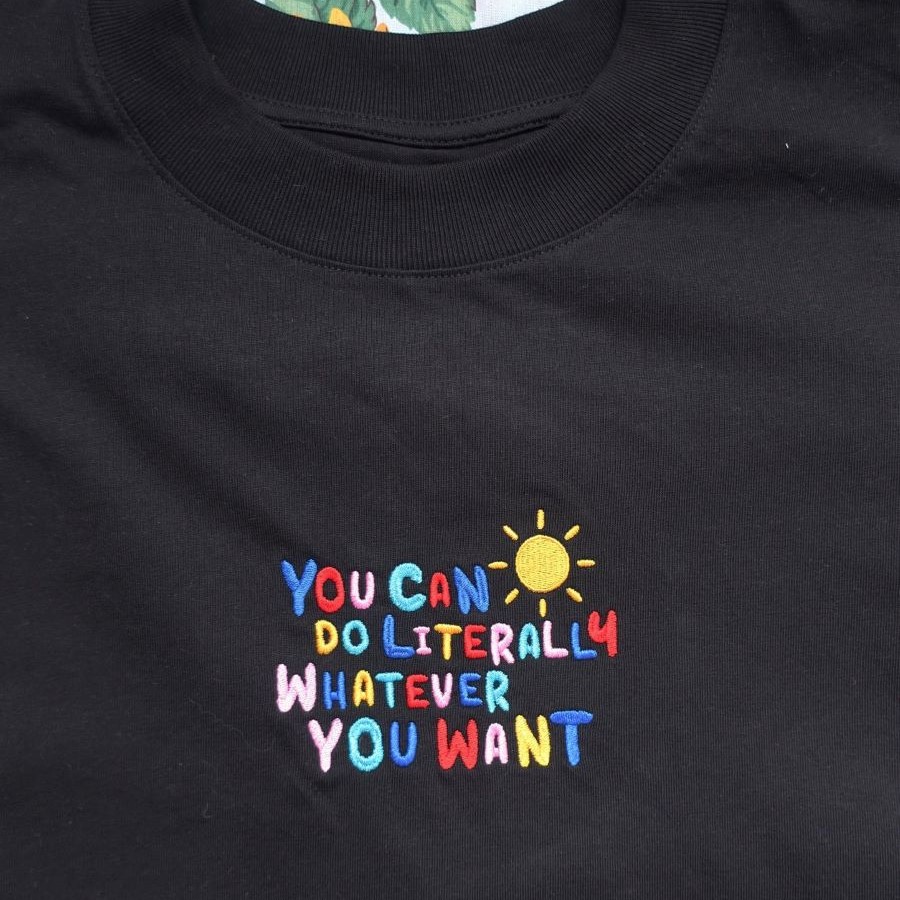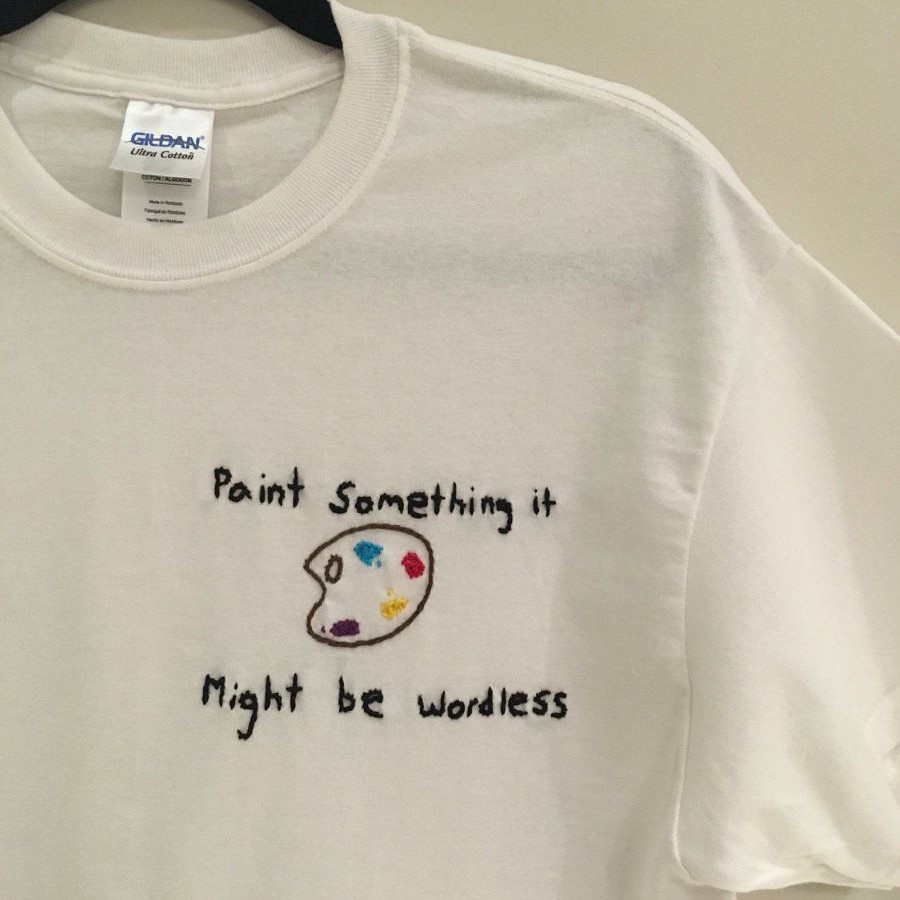Top 12 Embroidery Font Styles – Elevate Your Textiles Now!
Selecting the right embroidery font styles is critical to ensuring that the message you wish to convey is clear, aesthetically pleasing, and resonates with the viewer. Whether you’re monogramming a handkerchief, personalizing a gift, or branding company apparel, the font sets the tone. This comprehensive guide will delve into the intricate world of embroidery font styles, helping you navigate through the multitude of choices to find the perfect typeface for your thread-based projects.
How to Select the Ideal Embroidery Font Styles
Choosing the perfect embroidery font styles is an art in itself—one that requires attention to detail, an understanding of the medium, and a touch of creativity. As you embark on the journey to select the ideal font for your embroidery project, there are several factors to weigh that will ensure your final product is as functional as it is beautiful.
Size and Proportion
Consider the scale of your embroidery canvas; this will largely dictate the appropriate font size. Larger canvases like tote bags afford the luxury of experimenting with grand, bold fonts that can make a statement from across the room. Conversely, smaller items, such as beanies or collars, demand more delicate and finer fonts that maintain legibility even in compact spaces.

Tone and Personality
Embroidery is not just about visual appeal; it’s a form of communication. The tone of your font should mirror the message you intend to convey. For a playful, lighthearted design, whimsical fonts with quirky characters can inject fun into your embroidery.
These fonts often mimic handwriting and can add a personal touch to any design. On the other hand, if your goal is to maintain a sense of sophistication and professionalism, opt for clean-lined, simple fonts. These styles exude elegance and are timeless, making them suitable for more serious or classic designs.
Stitch Compatibility
Embroidery is the interplay between thread and fabric, orchestrated by the chosen font. Each font will interact differently with the types of stitches used in your design. Some fonts will shine with a basic running stitch, offering a rustic and minimalistic look, while others might require the denser coverage provided by satin stitches to truly pop.
Thin, delicate fonts can be lost if paired with heavy stitch patterns, while thicker fonts might prove too bold for light, airy stitch work. Always consider the type of stitches when selecting your font; this ensures that every letter is distinct and contributes to the overall beauty of your embroidered piece.
By considering these key elements — the size of your embroidery area, the desired tone of your design, and the compatibility with embroidery stitches — you can choose embroidery font styles that not only match your aesthetic but also perform beautifully in practice. Whether you’re aiming for impact or subtlety, the right font choice will elevate your embroidery from a simple stitched piece to a crafted work of art.
What Are Some Trending Embroidery Font Styles?
Embroidery font styles transform text into vibrant, artful expressions on any material. The beauty of embroidered text lies in its ability to mimic the personal touch of handwriting or the artistry of hand-lettering, often with the use of script fonts which include both cursive and calligraphy styles.
Though they fall under the same category, cursive fonts feature a flowing, connected character design, while calligraphy may present more stylized and individualized letterforms. Below, we explore some of the most cherished cursive and calligraphy embroidery fonts that continue to adorn fabrics worldwide.

Stitched
Stitched is a font that seems to leap straight off a sketchpad, with its dashed lines imitating a true running stitch. This font’s charm is in its deliberate imperfections—letters tilt whimsically and dots vary in placement, granting the impression of a handstitched piece. For those aiming for an authentically crafted appearance, Stitched offers just the right touch of handmade authenticity.
Cross Stitch Cursive
For a touch of tradition, Cross Stitch Cursive pays homage to the classic craft technique. Letters are designed to look as though they’ve been cross-stitched onto the material, with a slightly raised appearance to enhance the realistic effect. It’s a font that evokes nostalgia and is perfectly suited for projects that call for a vintage or heritage feel.
Good Morning
Good Morning ushers script fonts into the modern era with its elegant and fluid cursive handwriting. Characterized by high-contrast strokes and a notable x-height, this typeface stands out for its legibility and contemporary flair. It includes swash alternates for lowercase letters, offering versatility for various embroidery applications—from a chic café apron to a cozy lounge blanket.
Family Home
Family Home is a font that exudes warmth and comfort. With its smooth, voluptuous strokes and playful coiled letters accented with heart-shaped dots, it lends a romantic and homey feel to any embroidery design. Ideal for personal gifts or commemorative items, this font resonates with sentiments of love and togetherness.
Bodoni Terracina
The Bodoni Terracina font carries the legacy of its creator, the eminent Italian typographer Giambattista Bodoni. Its clean, thin strokes and consistent slant deliver a sense of royalty and sophistication. With excellent readability, this font is well-suited for formal embroidery pieces that require a touch of class and historical significance.

Cattieshine Font Bundle
Cattieshine offers an extensive range of possibilities with its font bundle. This collection features a hand-drawn sans serif font, a cursive script font available in multiple weights, an assortment of doodles, and swashes, as well as various floral ornaments and background patterns. It’s a comprehensive package for an embroiderer who loves variety and is ideal for creating a cohesive look across different items.
Stitch Warrior
Stitch Warrior enters the domain of embroidery font styles with a bold and textured presence. Crafted as a vector font, it’s optimized for embroidery, ensuring that each letter’s numerous tiny, scalable pixels come together to form a solid, textured appearance. This gothic-style calligraphy font adds an element of historical gravitas and personalization to your embroidery projects, making it a prime choice for pieces that require a distinctive, classic touch.
Good Day Font
The Good Day font is reminiscent of the smooth, tight satin stitch found in traditional embroidery. It showcases delicate calligraphy handwriting with its slender, high-contrast strokes, presented exclusively in uppercase. As a bitmap font, it retains clarity and detail across various sizes, making it a versatile option for both printing and embroidery purposes, ensuring that every message stands out with elegance.
Hodgeson
Hodgeson is a monoline slab serif font that elegantly blends the slab tradition with modern calligraphy flair. Available in four styles, it includes swashes, stylistic alternates, and ligatures that add a custom-lettered feel to any embroidery design. The heavy strokes, pronounced block serifs, and slightly compressed width make Hodgeson an adaptable font that is equally at home in both contemporary and classical embroidery settings.
Angon
Angon evokes a sense of nostalgia with its retro-style calligraphy design. It features bold, rounded strokes paired with clean wedge serifs and a generous x-height. Its distinct ligatures and special alternates, characterized by extended tails and eye-catching ball terminals, make it perfect for crafting vintage-inspired embroidery designs that capture the essence of bygone eras.
Milgnite
Milgnite is a display serif font that embodies modern calligraphy with its rigid, high-contrast strokes, accented by sharp, thin wedge serifs and a broad set width. The alternates boast unique teardrop terminals, which add to its sophisticated and opulent demeanor. This font is a match for designs that call for a contemporary yet classic elegance, imparting a sense of luxury to personalized embroidery work.
Retromax
Lastly, Retromax adds a creative spin to embroidery font styles with its distinctive reverse-contrast design. Available in three layered styles—3D, shade, and offset—it provides an opportunity to create a multi-dimensional effect on text, giving the illusion of depth and texture. This fun and distinctive font is ideal for embroidery designs that aim to stand out and make a statement with a touch of playfulness.
Discover the enchantment—scan the QR Code on our shirts for enhanced engagement. Unlock the magic now!
Pros and Cons of Machine Embroidery Fonts
Machine embroidery font styles epitomize precision and elegance, frequently imparting a luxurious appearance to diverse textiles. When it comes to incorporating text into embroidery projects, the choice of font is pivotal. While machine embroidery fonts can transform a simple piece of fabric into a work of art, it’s crucial to weigh the advantages and disadvantages before deciding on this method for your design. Here’s an updated take on the pros and cons of using machine embroidery fonts.

Pros of Machine Embroidery Fonts
- Elevated Aesthetics: Machine embroidery fonts have the power to elevate the appearance of any product significantly. The texture and dimension that embroidery adds can often enhance a design, making it stand out with a premium look.
- Exceptional Durability: Embroidered fonts are incredibly durable. Unlike some printing methods that might crack or peel, machine embroidery withstands wear and tear commendably, maintaining the integrity of the design through numerous washes and uses.
- Resilience to Fading: One of the substantial advantages of machine embroidery is its resistance to fading. Embroidery threads are typically colorfast, which means that the vibrant colors and sharp contrasts of your embroidered fonts will not fade over time, even with regular washing.
- Versatility in Fabric Choice: Machine embroidery is often suitable for a variety of fabrics, including those that are not ideal for other decorating methods. This includes thick and heavy textiles where print might not adhere well, making embroidery a versatile choice.
Cons of Machine Embroidery Fonts
- Cost Implications: The sophistication of machine embroidery fonts comes with a higher price tag. The process can be more expensive than other imprint methods due to the intricate work and materials involved.
- Limitations on Detail: Machine embroidery does not always cater well to extremely small lettering or very fine details. Intricate fonts or tiny text can lose clarity and become unreadable, as the stitches may not capture all the subtle nuances.
- Design Limitations Due to Stitch Count: The complexity of a design can be limited by stitch counts. Some embroidery machines have a maximum stitch count per design, which can restrict the size and detail of the fonts and images you want to incorporate into your embroidery.
- Restricted Font Selection: Although there are thousands of fonts available, not all are suitable for machine embroidery. The choice of fonts that can be effectively translated into stitches without losing their character is narrower than in other imprint methods, which might limit your options when it comes to design.
In conclusion, selecting the right embroidery font styles is essential in achieving a sophisticated and lasting impact on any textile. Whether you’re looking for durability, elegance, or a particular fabric application, the font styles available can define your project’s success. We invite you to explore Ricardo Seco Shop, where you can discover a curated collection of T-shirts and gain insightful information that will guide you in choosing the perfect embroidery font styles for your needs.
